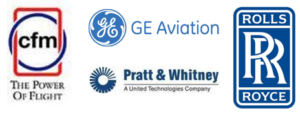Leeham News and Analysis
There's more to real news than a news release.
Focus on NMA engines: all OEMs vying for Boeing’s approval
Subscription Required
Now open to all readers.
Introduction
March 22, 2018, © Leeham Co.: As Boeing enters the final stretch whether to launch the New Midrange Aircraft (NMA, aka 797) market focus should shift to the  engines more than the airframe and even the market demand.
engines more than the airframe and even the market demand.
It all comes down to this: no engines, no plane.
Monday’s post outlined some of the issues to consider.
But there are larger implications as well.
Summary
- Market sources are tossing about various scenarios about the future GE Aviation and CFM.
- Rolls-Royce won’t have its Trent 1000 problems fixed until 2021 or 2022, at great cost.
- Pratt & Whitney won’t have its Geared Turbo Fan final PIP packages for its problems sorted out until around 2021.
- Resources—both financial and with engineering—are stretched now.
- Sequencing current engine problems, and in the case, GE’s GE9X, are a factor, in the eyes of some.
Discussion
GE Aviation
In the category of “who would have ever thought it,” financial issues at GE place question marks over the future of GE Aviation and CFM, in which GE is a 50% partner, in the minds of some industry observers.
GE’s financial services division is a drag on the corporate financial results. The company is openly exploring a break-up. These explorations include shopping GE Aviation (GEA) around, says a Wall Street aerospace analyst, though he doubts GEA would be sold. Others also doubt it; GE Aviation returns 20% margins and the analyst says GEA is the cash cow, largely subsidizing much of the rest of the company.
Still, GEA’s highly profitably after-market services is an attractive target for none other than Boeing, which wants to increase its share of the multi-trillion dollar aftermarket sector to $50bn within 5-10 years. Growing this much organically doesn’t seem possible, analysts say; mergers and acquisitions would have to be part of the strategy.
The CEO of Boeing Commercial Airplanes, Kevin McAllister, came from a similar position at GEA’s services division. He knows GEA and services intimately.
Setting aside the issue whether such an acquisition is even remotely like and whether a deal would ever clear anti-trust concerns, combining Boeing and GEA has other issues.
- It would effectively cut out any role by Pratt & Whitney or Rolls-Royce from future Boeing airplane programs, such as the NMA or successor to the 737.
- Would it kill the ability of CFM to sell engines to Airbus? GE owns 50% of CFM. CFM provides engines for the A320ceo and A320neo families.
- What would this mean for PW and RR? Would Airbus be compelled to acquire one in defense? Would PW and RR merge, as sometimes discussed?
If not a sale, then what?
If, for anti-trust or other reasons, Boeing did not acquire GEA, might another transaction take place?
Once again, the market whispers about Boeing entering some other financial deal with GEA, such as a loan or equity stake, should GEA be spun off. Many of the issues of an outright acquisition appear to remain concerning the broader market implications, but Boeing would obtain a slice of the engine aftermarket business for its Boeing Global Services.
CFM International
What of CFM International?
Another scenario that is whispered in the market is Boeing loaning GEA money to buy out Safran’s 50% stake in CFM. Given GE Aviation’s own financial strength, this seems as fanciful as Boeing acquiring GEA outright.
But divorcing from Safran is market talk that nevertheless a scenario being discusses.
“This would be suicidal for Safran in my opinion,” one European aerospace analyst wrote LNC.
“For Safran, this is a paramount asset, so I would be very surprised on the face of it if they agreed to sell,” a second European analyst wrote LNC. “Perhaps it could be structured so as to allow Safran to sell its equity stake in CFMI, but to remain as a very roughly 30% RSP (i.e. net of half of the total of the other RSP shares) with workshare to match. That would enable GE to consolidate fully and Safran essentially to carry on doing what it does with the cashflows and profits that it has.”
Competing for NMA
Despite plenty of overt and whispered doubts about the market viability of the NMA, all three engine manufacturers are submitting proposals to Boeing.
Down-selecting the engines is expected before the end of the year. There is a faction within Boeing that wants a dual-engine sourcing and airlines like to see competition.
However, lessors prefer a single engine choice and nearly all observers LNC talks with believes GE/CFM will eventually “buy” the sole-source position on the NMA.
Resources
As noted Monday, all the engine makers are digesting engine problems. Rolls-Royce continues to have issues with the Trent 1000 on the 787, with full resolutions not expected until 2021-22. GE Aviation continues to have issues with the GEnx on the 787 and Boeing 747-8. CFM’s LEAP 1A and 1B for Airbus and Boeing neos and MAXes have technical issues and overall production is behind schedule. The problems with the Pratt & Whitney GTF engines are widely known. Full resolution is also expected around 2021.
While some look at these problems and believe the OEM’s financial and engineering resources are stretched, which will make developing the NMA engines a challenge in the timeframe Boeing wants.
Some believe these concerns are overblown. Any of the engine makers will make the resources and money available to develop the NMA engine(s), should they be down-selected, it’s said.

